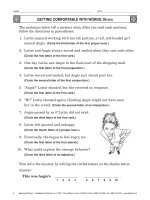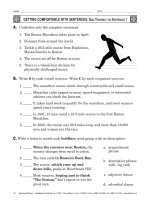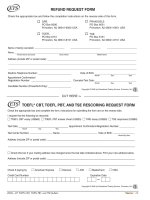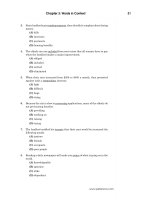Tài liệu Beginning writing 2 part 8 pptx
Bạn đang xem bản rút gọn của tài liệu. Xem và tải ngay bản đầy đủ của tài liệu tại đây (138.21 KB, 10 trang )
58
Beginning Writing 2
• Saddleback Publishing, Inc. © 2001 • Three Watson, Irvine, CA 92618 • Phone: (888) 735-2225 • Fax: (888) 734-4010 • www.sdlback.com
NAME DATE
1. Choose a topic.
2. Do the research. Find information
and take notes.
3. Write an outline.
4. Write a rough draft. Then proofread, revise,
and write a final copy of the report.
5. Write a bibliography—a list of the
sources you used for information.
When you choose a report topic, ask yourself the following questions:
Is the
topic limited enough to cover in two or three pages? Will it be easy for you to
find enough information on your topic?
A.
Answer the following questions in complete sentences.
1. What is the purpose of a report? _____________________________________
____________________________________________________________________
2. Would the United States be a good topic for a report? Why or why not?
____________________________________________________________________
____________________________________________________________________
3. If you were writing a report on the bald eagle, what are two places you
might look for information? __________________________________________
____________________________________________________________________
4. What is a bibliography? _____________________________________________
____________________________________________________________________
____________________________________________________________________
B.
Put a checkmark by each item that would be called a report.
WRITING A REPORT: W
HAT
I
S
A
R
EPORT
?
A
report
gives information on a selected topic. Sometimes your teacher may
assign the report topic. Other times, you may be asked to choose a topic yourself.
WRITING A REPORT INVOLVES THE FOLLOWING STEPS:
1. _____ a letter to a relative
2. _____ an advertisement for
television sets
3. _____ information about a
book you read
4. _____ information about the
Baltic Sea
5. _____ a poem about the seashore
6. _____ information about Yellowstone
National Park
7. _____ a fiction story about a bank
robbery
8. _____ information about the famous
bank robbers Bonnie and Clyde
CHALLENGE: Imagine your teacher has asked you to write a two- to three-page
report. On the back of this sheet, list three topics you would like to write about.
Saddleback Publishing, Inc. © 2001 • Three Watson, Irvine, CA 92618 • Phone: (888) 735-2225 • Fax: (888) 734-4010 • www.sdlback.com •
Beginning Writing 2
59
NAME DATE
WRITING A REPORT: T
HE
R
EPORT
I
NTRODUCTION
A typical report has three parts: a one-paragraph introduction, a body of at
least three supporting paragraphs, and a one-paragraph conclusion. The report
introduction serves the same purpose as a paragraph’s topic sentence. It presents
the main idea and sparks interest. The introductory paragraph does not need to
be long. Usually, two or three sentences will serve the purpose.
A.
Write T or F to show whether each statement is true or false.
1. _____ A report has an introduction, a body, and a conclusion.
2. _____ The introduction tells what the report is about.
3. _____ The introduction is usually two or three paragraphs long.
4. _____ The body is usually made up of only one paragraph.
5. _____ A report begins with a conclusion and ends with an introduction.
B.
Which introduction in each pair most clearly presents the topic and
serves to interest the reader? Circle the letter of the best introduction.
1. a. Among the heaviest of all land mammals is the hippopotamus.
Although its name means “river horse,” this gigantic beast is
not related to the horse at all. To study the hippopotamus, we’ll
journey to the swamps, streams, and marshes of tropical Africa.
b. Many animals live in Africa. These include the elephant, lion,
hippopotamus, and zebra. I am going to write about one of them.
2. a. The 1930s were among the toughest economic times American
workers have seen. Factories shut down and banks closed. There
were few jobs. This was the Great Depression.
b. This report is about people losing their jobs and not being able
to pay their bills. That is a terrible thing, as you can well imagine.
I would sure hate it if my family had no income, and we had to
give up our home and live on the streets!
3. a. This report is about dreams.
b. Where do elephants fly and shoppers
wear pajamas to the mall? In dreams!
Understanding dreams—both the happy
ones and nightmares—requires looking
at what happens as people sleep.
60
Beginning Writing 2
• Saddleback Publishing, Inc. © 2001 • Three Watson, Irvine, CA 92618 • Phone: (888) 735-2225 • Fax: (888) 734-4010 • www.sdlback.com
NAME DATE
WRITING A REPORT: T
HE
B
ODY
OF
THE
R
EPORT
I
There are three parts to a report: the introduction, the body, and the conclusion.
The body of the report includes paragraphs of information about the subject.
Each paragraph begins with a topic sentence. The other sentences in the
paragraph give details to support the topic sentence.
The topic sentences below could begin paragraphs in the body of a report
about alligators. Read the detail sentences that follow. Ask yourself which
topic sentence each detail sentence would support. Mark the letter of the topic
sentence next to the detail sentence. The first one has been done for you.
TOPIC SENTENCES
a. Alligators are large animals
with a lizard-like appearance.
b. Alligators are powerful hunters.
c. Alligators are often mistaken for
crocodiles, but are different from them in some ways.
DETAIL SENTENCES
1. _____ The alligator has a much larger, broader snout than the crocodile.
2. _____ Alligators eat small animals that live in or near water.
3. _____ Large male alligators have been known to attack pigs, dogs,
and cattle.
4. _____ The tough skin of the alligator is a dull gray and dark olive color.
5. _____ Luckily, alligators seldom attack humans.
6. _____ Alligators have a different tooth pattern than crocodiles.
7. _____ The alligator’s short, stout legs are used for walking but not for
swimming.
8. _____ Alligators are much less active and less savage than crocodiles.
9. _____ The alligator’s bulging eyes stick up above its skull.
10. _____ For the most part, alligators and crocodiles inhabit different regions.
11. _____ With its mighty jaws, the alligator grabs its prey and drags
it under the water.
12. _____ Most adult alligators range from 5 to 12 feet in length.
CHALLENGE: On the back of this sheet, begin a paragraph with one of the
topic sentences from above. Use information from the detail sentences
to support the idea and complete the paragraph.
c
Saddleback Publishing, Inc. © 2001 • Three Watson, Irvine, CA 92618 • Phone: (888) 735-2225 • Fax: (888) 734-4010 • www.sdlback.com •
Beginning Writing 2
61
NAME DATE
WRITING A REPORT: T
HE
B
ODY
OF
THE
R
EPORT
II
A.
Write a letter to match each topic sentence with a detail sentence that would
appear in the paragraph.
TOPIC SENTENCES
1. _____ Many young adults gain
experience by working
as interns.
2. _____ Young people can earn
good pay working as
restaurant servers.
3. _____ Volunteers choose to
lend a hand for many
reasons.
4. _____ A bike rider’s clothing
can prevent disaster.
5. _____ The kitchen is one of
the most dangerous
rooms in the house.
DETAIL SENTENCES
a. Pots and pans on the stove will
be safer with their handles
turned toward the back.
b. Volunteers can learn new skills
and make new friends while
helping others.
c. TV stations often employ
inexperienced trainees who
learn the business working
behind the scenes.
d. A friendly employee may receive
big tips from happy customers.
e. Even a short trip can end in a
bad fall, so it’s important to
wear a helmet at all times.
B.
Select an animal that interests you. On the lines below, write a paragraph
that could appear in the body of the report. Begin the paragraph with a
topic sentence. Then write at least three sentences of supporting details.
(Use a library book, textbook, Internet information, encyclopedia volumes,
or an electronic encyclopedia for information.)
TOPIC SENTENCE:
_________________________________________________________
_______________________________________________________________________
DETAIL SENTENCES:
_______________________________________________________
_______________________________________________________________________
_______________________________________________________________________
_______________________________________________________________________
_______________________________________________________________________
_______________________________________________________________________
_______________________________________________________________________
_______________________________________________________________________
62
Beginning Writing 2
• Saddleback Publishing, Inc. © 2001 • Three Watson, Irvine, CA 92618 • Phone: (888) 735-2225 • Fax: (888) 734-4010 • www.sdlback.com
NAME DATE
WRITING A REPORT: T
HE
R
EPORT
C
ONCLUSION
The conclusion of a report should refer back to the introduction. The concluding
paragraph usually restates the subject, sums up the information, and leaves the
reader with an interesting statement.
You might recognize the following introduction from an earlier exercise.
Reread the introduction and compare it with the report’s conclusion.
Circle a letter to answer each question that follows.
INTRODUCTION
The 1930s were among the toughest economic times American workers have ever
seen. All over the country, factories shut down and banks closed. There were very few
jobs. This was the Great Depression.
CONCLUSION
The Great Depression finally ended as World War II factories hired workers to build
tanks and make guns. The era of hardship, however, would remind future generations
that a “bust” can follow a “boom.” The Great Depression taught many Americans to
appreciate times of plenty and plan ahead for leaner years.
1. What is the topic of the report?
a. different generations throughout American history
b. saving for the future
c. the Great Depression
2. The writer related the topic to modern readers by saying that
a. World War II ended the Great Depression.
b. the Great Depression taught future generations to plan ahead
for bad economic times.
c. the Great Depression was really terrible.
3. How do the introduction and conclusion compare in length?
a. They are about the same length.
b. The conclusion is much shorter than the introduction.
c. The conclusion is much longer than the introduction.
CHALLENGE: Below is the introductory paragraph of a report. On the back
of this sheet, write a concluding paragraph that restates the subject and
leaves the reader with an interesting summary.
INTRODUCTION
Most people have missed school or work because of a cold. They’ve suffered
the runny nose, sore throat, and fever of the illness. What exactly is a cold, and
what can be done to avoid or cure one?









